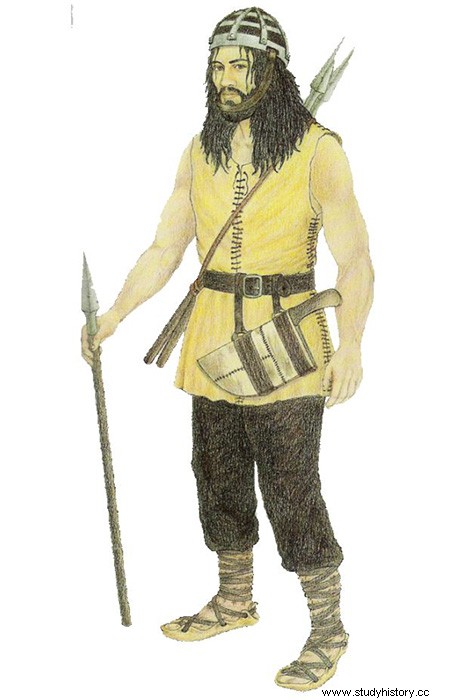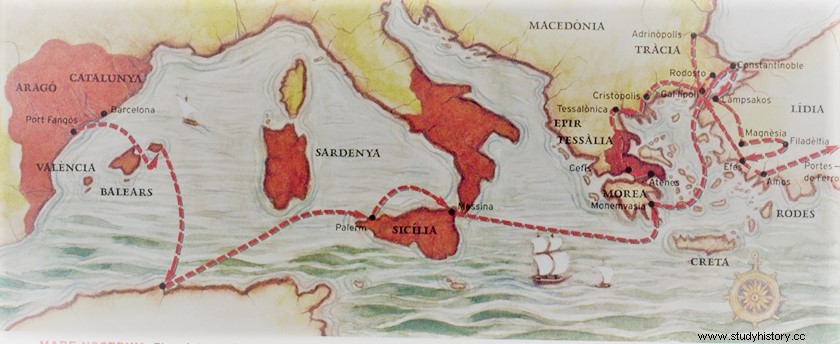
At the beginning of the 20th century, Greek politicians still They continued to curse the presence of the Almogavars, six centuries before, in Greek lands. Possibly forgetting that they were called upon by themselves, to shake off the Turks in the darkest hours of the Byzantine Empire. Neither saviors of an Empire, nor the most terrible warriors. Surely in the middle ground between the Byzantine sources and those based on Ramón Muntaner, one of the Almogavar protagonists who left his written memoirs. We find the truth of this amazing army of Catalans and Aragonese, who founded the duchies of Athens and Neopatria.

The work of Ramón Muntaner.
The origin of the Almogavars.
Since, in the 17th century, Francisco de Moncada aroused the interest of Hispanic historiography in the Almogávar army, several principles have been assigned to it. Some have dared to assign a Visigothic origin, due to the clothing with which they have been described to us, which are more similar to the Germanic barbarian peoples than to medieval soldiers.
This origin has been ruled out, since, if so, these groups would have also been found instead of fleeing from the Visigoths after the Muslim invasion, that is, in the Cantabrian mountain range. Therefore, its origin seems to be much simpler and more logical than we might think, in addition to coinciding with the birth of the Kingdom of Aragon, that is, three centuries before the events for which they are known. The conquering character of the newborn Christian kingdom offered a series of opportunities that the rough men of the mountains had to take advantage of. The arrival of Alfonso I the Battler expanded the Aragonese territories from the Pyrenees to the Iberian System, an enormous extension of totally unprotected borders, mainly due to two premises:the scarce military force and the border difficulties due to the wild mountains.
Well, a series of men seem to have devoted themselves, at their own risk, and especially profit, to the protection of these borders. The clothes with which they have been described and their way of fighting have helped to think about their common past. Their leather jacket, which they only abandoned in the harsh summer climates, their legs protected by leather breeches, or the sandals to climb the most mountainous terrain, are the best indicator of a pastoral past. The harsh living conditions of the Pyrenean mountains carved out the Aragonese and Catalan almogavars. The new way of life offered by the conquest of territories opened the door for them to live off the looting and looting of Andalusian border towns. At first, they did not submit to kings, nobles or towns, refusing to live in servitude at all times. The name by which they are known was given by the Muslim victims themselves, since the Arabic word al-mogavar means "he who makes trouble"

Clothing of an Almogávar soldier.
Although at first they were the Catalan and Aragonese Pyrenean shepherds, this way of life began to attract new characters to the history of the Almogavars. Among them were the Muslims themselves from the newly conquered territories, who had surely suffered the siege of the Almogavars, and who now decided to join that life, before fleeing to new horizons. Also the Navarrese in a smaller number, after an evident contact with the Aragonese due to the shared history. Finally, highlight the Valencians and Majorcans of the territories that the Crown of Aragon conquered.
The Almogávar army.
In this environment their particular army was created. His form of fighting was normally on foot. Although after a few years in Greece and extensive experience in combat, according to the Almogávar Ramón Muntaner himself, they began to ride a horse, but when they arrived at the meeting place with the enemy hosts they got off it, because they only knew how to fight like that. They were also made their own weapons as consistent as possible to their life system described. The same thing that they used for looting and plundering, running at full speed to flee to the shelter of the mountain or fighting when they were overtaken by the fast men on horseback, they used throughout their history against the heavy medieval armies.

Tour of the Mediterranean of the Almogávares.
To defeat the latter, they used the same system learned during years of pillage in the mountains. Both the surprise factor and the use of the terrain required uniforms and light weight weapons. Hence, they practically did not use protections, or chainmail, or breastplates, or huge shields. Rather a small shield to protect against melee, thrown weapons such as darts, or a small spear called an azcona and a large knife sharpened with great precision. They did not mind killing the horse before the knight, since the latter on foot was easy prey for an Almogávar.

Almogávares with the flag of Aragon.
Finally, it should be noted that the structure of the Almogávar army was very simple. Three unique categories, common soldier (almogávar), sergeant (almocadén) and captain (leader), although to go from one to another more than half a life was needed, and extensive experience in combat. They did not mind, when they had to go as mercenaries to the great medieval armies, to put themselves under the command of a noble lord, yes, with proven experience in combat.
This army did not go unnoticed by the Aragonese kings, it seems that Alfonso I the Battler used them to conquer Zaragoza. But what is not in doubt is his participation under the orders of Jaime I, in the conquest of the Muslim kingdom of Valencia from 1229. As well as one of his most notorious victories, in the conquest of the island of Sicily, under the orders of Jaime I's successor, his son Pedro III.

Roger de Flor, commander of the almogavars entered Constantinople.
If any aspect of the Almogávar army stood out, it was its strange feeling of belonging to the Crown of Aragon. A curious section, since free men, who fought as mercenaries in the service of the highest bidder, never forgot their battle cry before starting the battle. Aragon! ¡Aragón!, combined with the patron saint ¡San Jorge!, and without forgetting the famous ¡Desperta ferro!, with which they began the battle after making sparks fly from their sharp knives. Not even in their well-known conquest of Athens did they forget their Aragonese origin. Before leaving for his most important mission; the call for help from the Byzantine Emperor Andronicus II, before the advance of the Turks towards Constantinople, made them promise that no one would force them to advance behind a flag other than that of the Crown of Aragon.
More info:
The Almogáveres, Jose M. Moreno Echevarría, Plaza &Janes, 1972.
